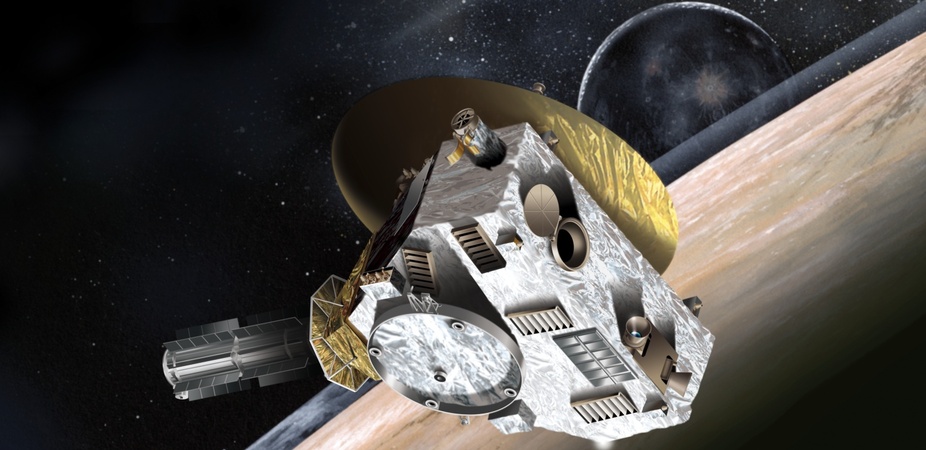By Jonti Horner, University of Southern Queensland
Last week, scientists using one of the Hubble Space Telescope’s Wide Field Cameras announced the discovery of a small moon orbiting the dwarf planet Pluto – the fifth satellite discovered in orbit around the object to date.
It joins the previously discovered Plutonian moons Charon, Nix, Hydra and S/2011 (134340) 1, and means the only objects known to have more moons than Pluto are the giant planets – Jupiter, Saturn, Uranus and Neptune.
But aside from adding another tiny species to the zoo of solar system objects, why is this discovery interesting?
To answer that question, it’s probably best to start with a little historical background on the discovery of the other members of the Pluto family.
Family secrets
Pluto’s first moon, Charon, was discovered back in 1978 by American astronomer James Christy, who had been taking images of Pluto noticed that, in some of them, the “planet” (as it was considered at the time) was noticeably elongated, and that elongation was periodically appearing, disappearing and then reappearing.
Charon is a remarkable beast. In many ways, it’s probably better to describe Charon and Pluto as a double-dwarf-planet. Its diameter is a little more than half that of Pluto, and it’s mass is a bit more than one tenth of Pluto’s.
In 2005, Nix and Hydra were discovered. Interestingly, they were quickly found to move on circular orbits in exactly the same plane as Charon, with orbital periods almost exactly four times and six times that of the Pluto-Charon binary – a quirk that may well reflect the way in which the system as a whole formed.

NASA; ESA; M. Showalter, SETI Institute
In 2011, the Pluto family grew once again, with the discovery of the tiny satellite S/2011 (134340) 1. This new moon was found to lie between the orbits of Nix and Hydra, slotting into the remarkably ordered Pluto system with an orbital period of almost exactly five times that of the Pluto-Charon binary.
Finally, on June 11, the Pluto system was brought up to its current tally of six bodies, with the discovery of the latest satellite, S/2012 (134340) 1. While its orbital period is yet to be definitely confirmed, it has been estimated to be in the region of 20.2 days – very close to three times that of the Pluto-Charon pair.
Remarkably, that means the ordered Pluto system seems to contain objects with orbital periods in the following sequence: 1:3:4:5:6.
New Horizons
The discovery of Pluto’s new satellite came about as part of an ongoing program of observations using the Hubble Space Telescope. That program was designed to search the area close to the dwarf planet for any debris that might interfere with the encounter between Pluto and the New Horizons spacecraft, scheduled to fly through the system on the July 14, 2015.

NASA/Kim Shiflett
New Horizons is a hugely ambitious space mission. Over the last 50 years, we have sent spacecraft to each of the Solar system’s planets. We have visited objects in the asteroid belt (including Dawn, a mission to the dwarf planets Vesta and Ceres).
Our probes have flown by, and even landed on, near-Earth asteroids.
We have even sent a 500kg block of metal to collide with a short-period comet. But we have never visited any of the vast number of small, icy bodies that lurk beyond the orbit of Neptune – at least, not until now.
At the time of New Horizons’ launch, in January 2006, Pluto was still considered a planet – and New Horizons was billed as being the first mission to the only unexplored planet in the solar system.
Despite having been launched from the Earth-Moon system at a greater speed than any other space mission, before or since, the vast distance to Pluto means New Horizons will have travelled for nine and a half years before it reaches the Pluto system.
After almost nine years of relative calm, the New Horizons team will go into a frenzy, trying to gather as much information about the Pluto system as possible as it tears past the planet at a speed of almost 14km a second.
The results of the mission will help us refine our understanding of the formation of the Pluto system, and also that of our solar system as a whole – and will doubtless throw up as many mysteries and new questions as those it answers.
So could Pluto be a planet after all?
Quite simply – no! Two of Pluto’s dwarf planet brethren have also been found to host satellites – Eris is accompanied by at least one moon (Dysnomia); Haumea has at least two moons (Hi’iaka and Namaka).
Haumea is also the largest body in a well-studied collisional family that contains a number of large (100 km or greater) bodies strewn through the Edgeworth-Kuiper belt.

Lexicon
All these satellites, and Haumea’s collisional family, are simply the relics of ancient giant collisions that shattered once larger bodies, leaving the dwarf planets we see today.
The fact remains that, despite its fame and its former planetary status, Pluto remains a tiny, low-mass body, floating on an eccentric orbit beyond the realm of the solar system’s giant planets.
A whole gaggle of other objects, the Plutinos, are known to move on very similar orbits to Pluto – shepherded and corralled by the gravitational influence of the giant planet Neptune.
The fact Pluto isn’t a planet doesn’t mean it isn’t an amazing and fascinating object. I’m really looking forward to seeing what New Horizons can tell us about Pluto and its family – I’m sure that many more exciting surprises are still to come!
![]()
This article was originally published on The Conversation.
Read the original article.



